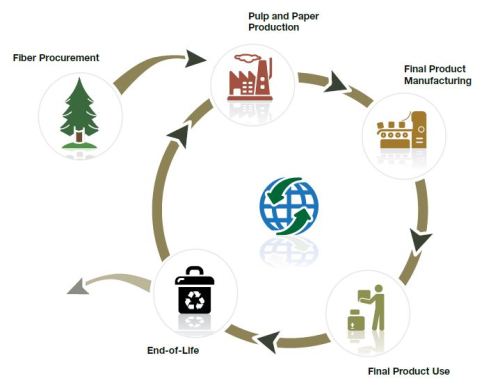Our new web page is up: Responsible Production and Use of Print and Paper
The objective of this resource is to help support a key element of the Two Sides mission which is to “promote the responsible production and use of print and paper”.
Whether you are reading a book or magazine, or writing notes on a piece of paper, the product you are using (print or paper…or both) has had a long and, sometimes complex, life before ending up in your hands. What you do with it, i.e. keep it or recycle it, will also determine its overall impact on the environment.
This “life cycle” is key to understanding the overall environmental footprint of print and paper products. The key factors driving this footprint are:
- Raw material production, including forest management and the collection of recovered paper
- Pulp and paper manufacturing
- Printing and converting
- Disposal and recycling
- Transportation at various steps of this life cycle
As usual, when we start looking into the life-cycle of products, things get complicated due to the numerous steps and actors involved.
In the case of paper and print, recycling and ensuring that forests are certified to standards such as SFI and FSC are a few examples of responsible production and use, but these are only the first basic steps in a much larger and complex life cycle.
Our new webpage outlines the life cycle of print and paper in more detail and the various ways in which producers and buyers can reduce the environmental impacts of their products. It includes links to the following ten Reference Sheets, which are loaded with examples of topic-specific tools, reports and articles from our member companies, allied organizations and other well-know and credible sources:
- The Paper Life Cycle – Resources explaining “life cycle thinking” and how to aim for a continual reduction in the environmental footprint of print and paper.
- Sustainable Forest Management – Information on best practices, forest certification and how to curb illegal logging.
- Clean Production – Example of best practices for manufacturing pulp and paper, including energy efficiency and water reduction.
- Climate Change and Carbon Footprint – Selected examples of how companies can determine their carbon footprint and reduce it, and how climate change creates not only challenges, but opportunities, for print and paper.
- Recycling and Use of Recovered Paper – What is sustainable use of recycled fiber? Statistics on fiber use, import and export.
- Environmental Reporting – Examples of resources supporting open and transparent sustainability reporting.
- Eco-Labels and Environmental Claims – Information to help readers understand the various eco-labels and what is behind them, and to cut through the “greenwashing”.
- Guidelines for Responsible Paper Production, Use and Procurement – Guides and tools published by credible organizations to help define responsible procurement, production and use.
- Examples of Responsible Paper Procurement Policies – Policy examples from leading companies that are setting the pace for responsible paper procurement.
- Environmental Scorecards and Product Declarations – Examples of paper scorecards and declarations used to evaluate the environmental performance of various paper grades.
I invite you to share this information with your co-workers, customers, suppliers and others, and take an active part in the conversation about on the sustainability and value of print and paper.
Two Sides feels that the US Graphic Communications Value Chain has a great story to tell about the responsible production and use of print and paper, and about the perks that this value chain provides our communities.
Phil Riebel
President and COO, Two Sides US

